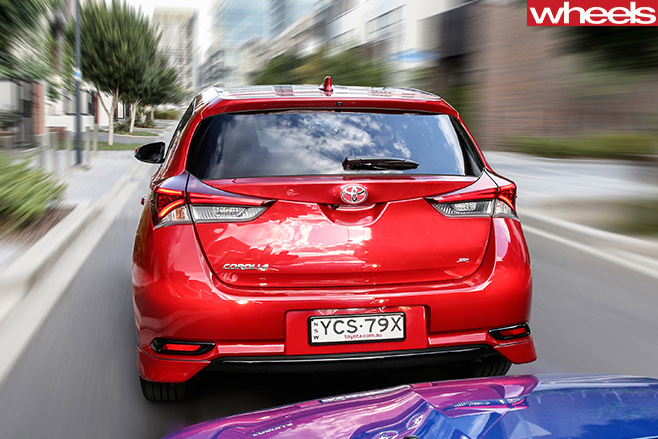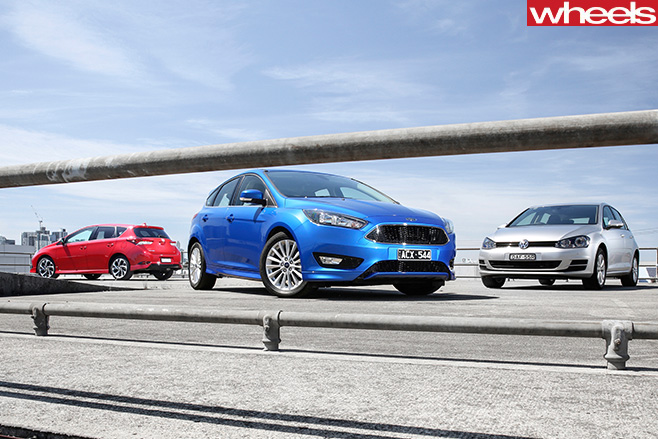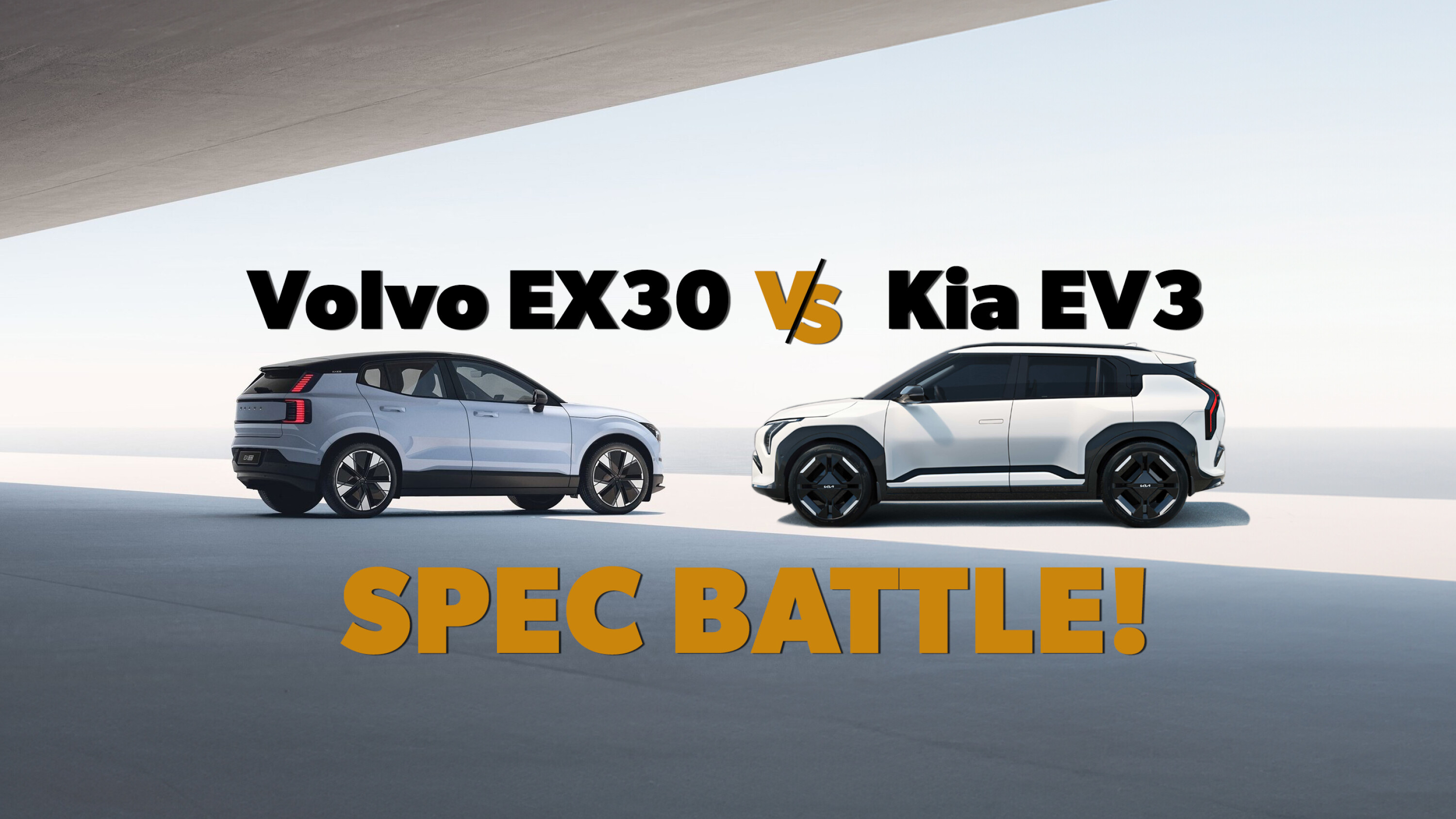These three hatchbacks hit the sweet spot. But have Corolla and Focus improved enough to reel in the mighty Golf?
Can’t wait to see the final scores? Jump to the verdict now.
SCIENTISTS first coined the term ‘The Goldilocks Zone’ to describe the narrow distance band from a sun that can support life. Not too hot, not too cold, all that stuff. In our solar system, Earth is pretty much it. Let’s care more for her.
Similarly, the Golf class, as the C-segment is often described, has long been the car industry’s sustainable sweet spot, with the Volkswagen, Ford Focus and Toyota Corolla regularly duking it out for global best-selling honours.
Australia, of course, is no exception, though it’s the Corolla and Mazda 3 that battle for number-one status. Small cars rule, while their similarly sized SUV offshoots (the RAV4 and CX-5 respectively) back them up for outright popularity.
More power to Ford
Coincidentally, the Corolla, Golf and Focus have all undergone change during 2015, prompting this shootout. Does this market’s perennial underdog Ford have what it takes to challenge the class benchmark Volkswagen and the best seller Toyota?

The results make it the most powerful mainstream small car in history. The sweet but toothless old 92kW/159Nm 1.6-litre base and mainstay 125kW/202Nm 2.0-litre GDi atmo units have given way to a 132kW/240Nm 1.5-litre ‘Ecoboost’ turbo tearaway, driving the front wheels via a six-speed manual or six-speed torque-converter auto. Both the problematic dual-clutch and the diesel have been binned.

We’ve gone for the $27,490 Sport auto, which also brings to the table a bodykit, 17-inch alloys, “sports tuned” suspension, dual-zone climate control, keyless entry and start, folding mirrors, auto headlights and wipers, a ritzier lighting pack, a leather steering wheel, and this group’s only DAB+ digital radio. Three cheers for the grandson of Laser TX3.

Luck, for a change, is on Ford’s side. No stranger to controversy of late, Volkswagen is embroiled in a global diesel emissions cheating scandal that not only tarnishes the Golf but also threatens to derail the German giant. Mistrust hangs over our 2013 Car of the Year winner like the fumes from the brand’s so-called Clean Diesel TDIs. In which case, there’s never been a better time for rivals to capitalise on Wolfsburg’s monumental mistake.

Of the trio, only the Golf also offers a range of driver-assist safety options such as Autonomous Emergency Braking (AEB) at our sub-$30K price point, further underlining Volkswagen’s tech savvy.

Toyota released the revised Corolla in June, springing a surprisingly effective nose and tail-light update on the three-year-old 11th-gen series, while also introducing a reshaped dash, prerequisite multimedia spruce with camera, smarter instrument dials, revisions to the steering and suspension, increased quietness, and an overhauled Continuously Variable Transmission promising handy fuel consumption cuts.
A tale of three autos
That’s right, folks – with CVT, dual-clutch and torque-converter trannies here, this is as much a test of small automatics as anything else.

Predictably, in this downsized turbo company the Toyota feels dated. The 2ZR-FE twin-cammer is tuned to feel terrifically responsive off the mark, with a fast and flowing torque delivery across most urban speeds, accompanied by a typically ultra-smooth CVT action. At 100km/h the tacho is barely touching 2000rpm. If only taxi journeys were this effortless.

At freeway overtaking speeds, Corolla’s engine starts to run out of puff (and refinement) as the others are streaking away. The numbers say it all. Ten-dead was the best we could coax to 100km/h, while 17.3sec to 400 metres is a whole second behind the hard-charging Focus. As with the rest of the group, the trannie shifts up even in manual mode, making the paddles seem a waste when the CVT is always calling the shots.

On paper, you’d expect the Focus’s 40kW and 40Nm advantage to obliterate the 92kW/200Nm Golf, but a 150kg weight penalty almost evens things up. We wonder how the Wolfsburg Kid would’ve fared with more than its barely run-in 1100km on the odo, against the Ford’s 5000km.
Rawer and rortier than either of its rivals at take-off, the latter’s lauded Ecoboost 1.5 charges energetically up through the gears. While the Focus seems faster and more frenetic than its disappointing 8.8sec 0-100km/h result suggests, a slight yet persistent gruffness does take the shine off its appeal somewhat. And that thumb-operated manual gearshift toggle feels as alien as ever to operate. Lose it, Ford.

Poise, discipline and composure
It also sets the handling and ride benchmarks, with consistent, precise and responsive steering that manages to skilfully filter out unwanted feedback without sacrificing feel. Backed up by an eager and agile chassis, the Golf corners with cracking poise and control, soaking up bumps with exceptional quietness (though the tyres are 16s compared to the 17s of the others). It’s an ultra-composed handler that never puts a single foot wrong dynamically.

And the Corolla? Aided by a set of quality Michelin 215/45R17 tyres, the ZR proves surprisingly fluid and flat in its handling composure, carving through corners in a safe and predictable manner. But there is a detached, steering-by-numbers sense to the Toyota’s dynamic dialogue, so you don’t ever feel as connected to the experience. And if the bitumen starts to deteriorate, so does Corolla’s comfort, with the ride becoming fidgety and unsettled, accompanied by plenty of road noise intrusion.

The rather funky Corolla, in contrast, is proudly Japanese-modern, simple to navigate and quite appealing from the front seat, but – like the spacious Ford – not in the Golf class as far as rear-seat accommodation is concerned. All have large and practical boots, with low loading lips, but only the Corolla includes a full-size 17-inch spare.
Is this as good as it gets?
Despite all the controversy surrounding Volkswagen, the Golf 92TSI Comfortline easily remains at the top of its game, perhaps the best all-round new-car buy in the world today. Three years on from its international launch, the Mk7 is still astoundingly complete, and remarkable value for money.
The facelifted Focus is a fine effort, with pricing and positioning reflecting Ford’s desperation to become relevant to Australian consumers again. What it lacks in polish is more than made up for in performance, dynamics, comfort, equipment levels, personality and charm. It has probably the best automatic gearbox from a long-term ownership proposition, but the LZ Focus is heavy, relatively thirsty and feels like it has merely caught up with the previous-gen Golf VI, rather than eclipsing the Golf VII.

The latest Focus really is a cracker, though. Volkswagen, Toyota and others… you are on notice. Yet, despite the Ford’s driver appeal, Golf remains the small-car sweet spot.
Class of ’76
EVEN though several generations separate them, we reckon the Golf LS, Escort XL and Corolla SE of 1976 would have finished in about the same order as their descendents. The 55kW 1.6-litre VW cost $4358 ($25,600 today), the 48kW 1.3-litre Ford was $4015 and the 54kW 1.2-litre Toyota set you back $3779. All had four-speed manuals, but offered a three-speed auto for around $380 ($2230) more. Escort and Corolla were rear-drive, Golf FWD.
Verdict
 VOLKSWAGEN GOLF COMFORTLINE
VOLKSWAGEN GOLF COMFORTLINE
Price as tested: $28,490 *Includes metallic paint ($500)
NCAP rating: 5 stars (Aus)
Fuel economy: 8.1L/100km (test average)
Acceleration: 0-100km/h: 9.1sec (tested)
Plus: Refinement; efficiency; performance; handling; ride; quality; packaging
Minus: Some DSG lag; no voice control; slightly underdamped fully loaded
Verdict: 9.0/10
 FORD FOCUS SPORT
FORD FOCUS SPORT
Price as tested: $27,940 *Includes metallic paint ($450)
NCAP rating: 5 stars (Aus)
Fuel economy: 10.0L/100km (test average)
Acceleration: 0-100km/h: 8.8sec (tested)
Plus: Strong performance; sharp handling; comfy ride; warm-hatch feel
Minus: Thirsty; rear seat comfort issues; no driver-aid safety availability
Verdict: 8.0/10
 TOYOTA COROLLA ZR
TOYOTA COROLLA ZR
Price as tested: $30,940 * Includes metallic paint ($450) and ‘Skyview’ glass roof ($1500)
NCAP rating: 5 stars (Aus)
Fuel economy: 8.5L/100km (test average)
Acceleration: 0-100km/h: 10.0sec (tested)
Plus: Ease and efficiency; improved interior quality; urban zip; reliability; resale
Minus: Firm ride; loud engine; flat front seats; short service intervals
Verdict: 6.5/10





